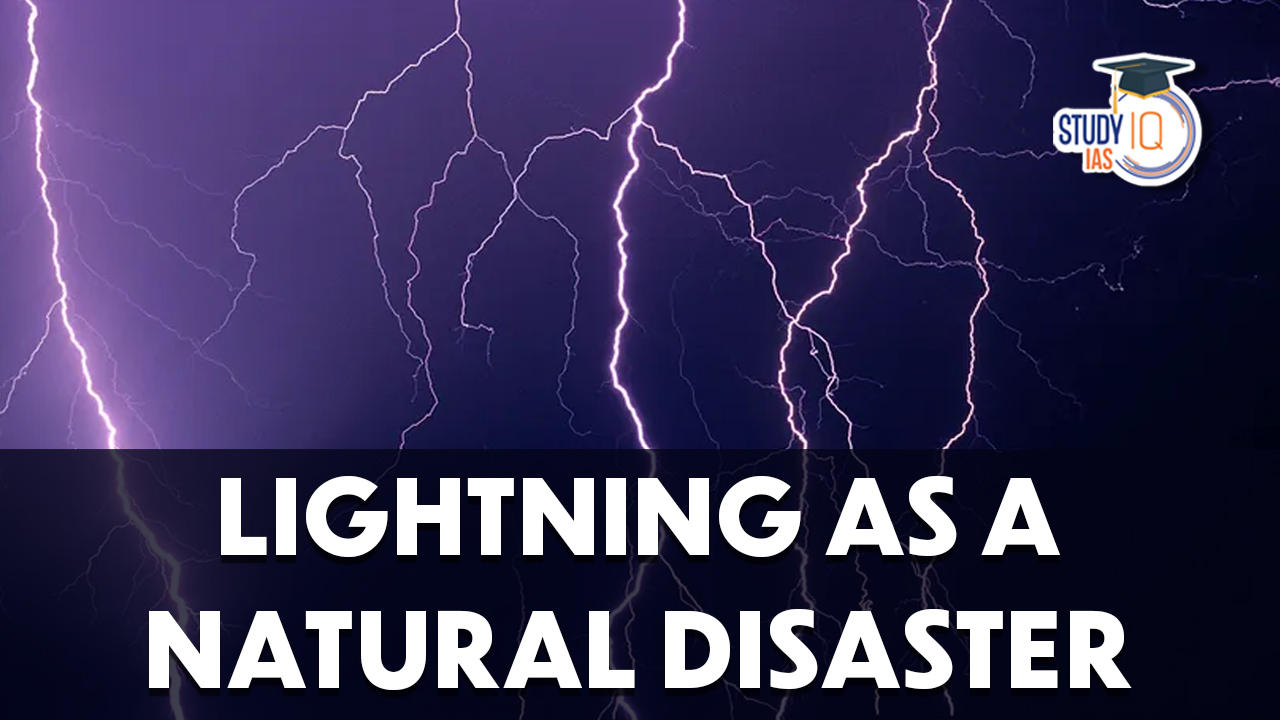Table of Contents
Context: The Union government has declined the request of several state governments to declare lightning as a natural disaster.
More on the News
- The union government declined the request as it opines that deaths caused by lightning can be prevented by making people aware of safety measures.
- India is among only five countries in the world that has an early warning system for lightning — the forecast is available from five days to up to three hours.
- The States such as Bihar and West Bengal have been demanding that lightning deaths be covered as a natural disaster.
- Once this is notified, the victims will be entitled to compensation from the State Disaster Response Fund (SDRF). The Centre makes 75% of the contribution to the SDRF.
- Cyclone, drought, earthquake, fire, flood, tsunami, hailstorm, landslip, avalanche, cloudburst, pest attack, frost and cold wave are now considered disasters under the SDRF.
What is a Natural Disaster?
- A disaster is a result of natural or man-made causes that leads to sudden disruption of normal life, causing severe damage to life and property to an extent that available social and economic protection mechanisms are inadequate to cope.
- In India, the criteria for declaring a disaster as a natural disaster are typically based on the guidelines provided by the National Disaster Management Authority (NDMA).
- Non-Anthropogenic: The disaster should not be primarily caused by human activities or interventions and should result from natural phenomena beyond human control.
- Impact: The disaster should cause significant damage, loss of life, or disruption to the environment, infrastructure, or socio-economic activities, requiring specialized response and recovery measures.
- Verification: The occurrence and impact of the disaster should be verified and confirmed by relevant government authorities, scientific institutions, or disaster management agencies.
- Recognition: The disaster should be recognized as a natural disaster by the concerned state or central government authorities responsible for disaster management.
About Lightning
- Lightning is a natural electrical discharge that occurs during thunderstorms.
- It is a sudden and powerful release of electrical energy between the clouds and the ground or between different regions within a cloud.
- The phenomenon is caused by the buildup of electrical charges within the clouds, as well as between the clouds and the Earth’s surface.
- When the electrical potential difference between these charged regions becomes significant, it results in a rapid discharge of electricity in the form of a bright flash of light known as lightning.
- This electrical discharge can be extremely hot, reaching temperatures of up to 54,000 degrees Fahrenheit (30,000 degrees Celsius), which is about five times hotter than the surface of the Sun.
- The rapid expansion of heated air around the lightning channel creates a shockwave that we hear as thunder.
- Thunder is the sound produced due to the superheated air rapidly expanding and then contracting as it cools down.

Lightning Strikes in India
- Lightning Strikes: There were 18.5 million lightning strikes in the country between April 2020 and March 2021 – 34% higher than the previous year – according to the Climate Resilient Observing Systems Promotion Council.
- The Indian Institute of Tropical Meteorology, Pune, has also reported a sharp uptick in strikes in the decade since 1995.
- Deaths due to Lightning: According to a report by the Lightning Resilient India Campaign, 90,632 people died by lightning between 1972 and 2019.
- National Crime Records Bureau (NCRB) data show that 2,880 people died in lightning strikes in 2021. While 2,862 people died in 2020, the number stood at 2,876 in 2019.
- These deaths made up 40% of all accidental deaths caused by “forces of nature”.
- According to IMD, the frequency of lightning was the highest in northeastern States and in West Bengal, Sikkim, Jharkhand, Odisha and Bihar, but the number of deaths is higher in the central Indian States of Madhya Pradesh, Maharashtra, Chhattisgarh and Odisha.
Impact of Lightning Strikes
- Injuries and Fatalities: People caught outdoors during lightning storms are at risk of being struck by lightning, which can lead to serious injuries or even death.
- Approximately 6000-24,000 people are killed by lightning strikes yearly around the world.
- Wild Fires: When lightning strikes dry vegetation, it can start a fire that can spread rapidly, causing damage to forests, wildlife habitats, and property.
- Lightning is the major cause of the natural ignition of wildfires worldwide and produces the largest wildfires in some regions.
- Property and Infrastructure Damage: Lightning strikes can damage buildings, power lines, communication systems, and other infrastructure
- Agriculture Sector: Frequent lightning strikes adversely impact small and marginal farmers.
- Around 77 per cent of farmers are killed due to lightning as they work in agricultural fields during the Kharif cropping season in the monsoon period.
- Impact on Wildlife: Lightning strikes can harm wildlife populations, either through direct strikes or by causing wildfires that destroy their habitats and food sources.
- Rural Areas: Mainly, rural and forest areas are the most vulnerable due to lightning because of the presence of water bodies and tall trees, with almost 96 per cent of deaths occurring in rural areas compared to urban areas.
- Tribal Population: The Annual Lightning Report 2020-2021 confirms that 60-70 per cent of deaths occurred in tribal populations due to lightning in Jharkhand, Odisha, Madhya Pradesh, West Bengal, and other states.
- Environmental Nitrogen Fixation: Lightning contributes to nitrogen fixation in the atmosphere, which is vital for enriching soil and supporting plant growth.
Lightning and the Climate Change
- In a 2015 study from California University, the university cautioned that a rise in one degree Celsius would result in a 12% increase in the frequency of lightning strikes.
- Another study that was released in Geophysical Research Letters in March 2021 found connections between climate change and an increase in lightning strikes in the Arctic.
About the State Disaster Response Fund (SDRF)
- SDRF has been constituted under Section 48 (1) (a) of the Disaster Management Act, 2005.
- It was constituted based on the recommendations of the 13th Finance Commission.
- It is the primary fund available with the State governments for responses to notified disasters to meet expenditure for providing immediate relief.
- It is audited by the Comptroller and Auditor General of India (CAG) every year.
- Contribution:
- The Centre contributes 75% of the SDRF allocation for general category States and Union Territories and 90% for special category States and Union Territories (northeastern States, Sikkim, Uttarakhand, Himachal Pradesh, Jammu and Kashmir).
- The annual Central contribution is released in two equal installments as per the recommendation of the Finance Commission.
- Disaster (s) Covered under SDRF: Cyclone, drought, earthquake, fire, flood, tsunami, hailstorm, landslide, avalanche, cloudburst, pest attack, frost and cold waves.
- Local Disasters: A State Government may use up to 10% of the funds available under the SDRF for providing immediate relief to the victims of natural disasters that they consider to be ‘disasters’ within the local context in the State and which are not included in the notified list of disasters of the Ministry of Home Affairs.


 Delimitation, Women's Quota
Delimitation, Women's Quota
 A collective effort towards peace in Mya...
A collective effort towards peace in Mya...
 A Picture Of A Growing Economic Divide I...
A Picture Of A Growing Economic Divide I...



















